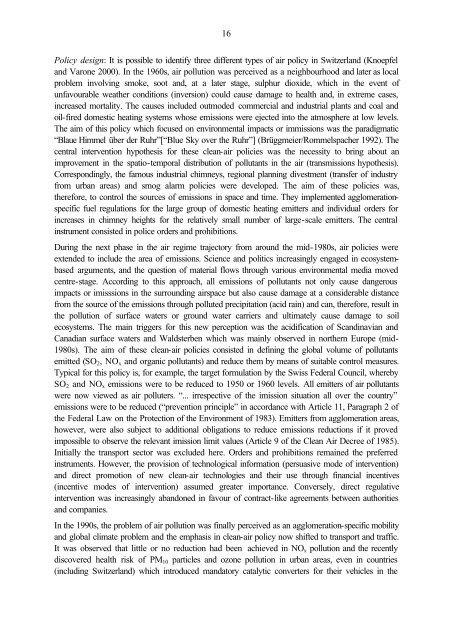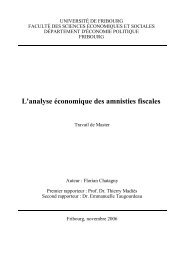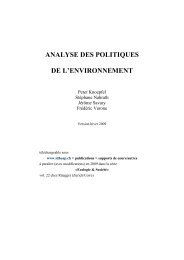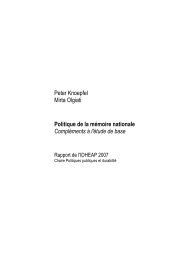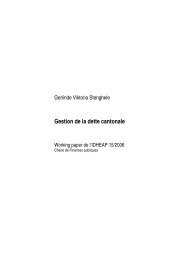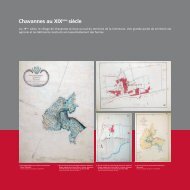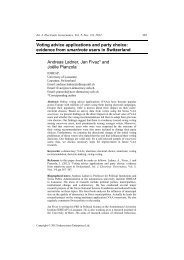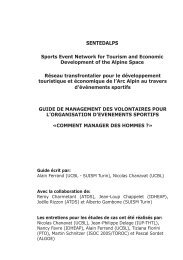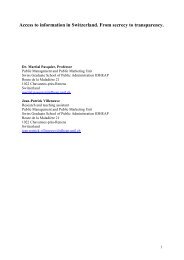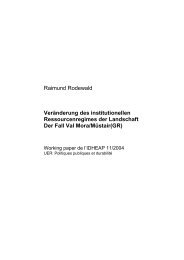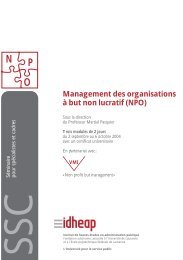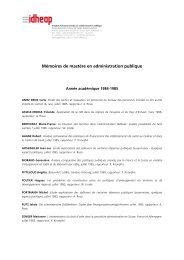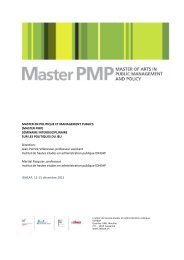Historical Analysis of Institutional Regimes in Switzerland ... - IDHEAP
Historical Analysis of Institutional Regimes in Switzerland ... - IDHEAP
Historical Analysis of Institutional Regimes in Switzerland ... - IDHEAP
Create successful ePaper yourself
Turn your PDF publications into a flip-book with our unique Google optimized e-Paper software.
16<br />
Policy design: It is possible to identify three different types <strong>of</strong> air policy <strong>in</strong> <strong>Switzerland</strong> (Knoepfel<br />
and Varone 2000). In the 1960s, air pollution was perceived as a neighbourhood and later as local<br />
problem <strong>in</strong>volv<strong>in</strong>g smoke, soot and, at a later stage, sulphur dioxide, which <strong>in</strong> the event <strong>of</strong><br />
unfavourable weather conditions (<strong>in</strong>version) could cause damage to health and, <strong>in</strong> extreme cases,<br />
<strong>in</strong>creased mortality. The causes <strong>in</strong>cluded outmoded commercial and <strong>in</strong>dustrial plants and coal and<br />
oil-fired domestic heat<strong>in</strong>g systems whose emissions were ejected <strong>in</strong>to the atmosphere at low levels.<br />
The aim <strong>of</strong> this policy which focused on environmental impacts or immissions was the paradigmatic<br />
“Blaue Himmel über der Ruhr”[“Blue Sky over the Ruhr”] (Brüggmeier/Rommelspacher 1992). The<br />
central <strong>in</strong>tervention hypothesis for these clean-air policies was the necessity to br<strong>in</strong>g about an<br />
improvement <strong>in</strong> the spatio-temporal distribution <strong>of</strong> pollutants <strong>in</strong> the air (transmissions hypothesis).<br />
Correspond<strong>in</strong>gly, the famous <strong>in</strong>dustrial chimneys, regional plann<strong>in</strong>g divestment (transfer <strong>of</strong> <strong>in</strong>dustry<br />
from urban areas) and smog alarm policies were developed. The aim <strong>of</strong> these policies was,<br />
therefore, to control the sources <strong>of</strong> emissions <strong>in</strong> space and time. They implemented agglomerationspecific<br />
fuel regulations for the large group <strong>of</strong> domestic heat<strong>in</strong>g emitters and <strong>in</strong>dividual orders for<br />
<strong>in</strong>creases <strong>in</strong> chimney heights for the relatively small number <strong>of</strong> large-scale emitters. The central<br />
<strong>in</strong>strument consisted <strong>in</strong> police orders and prohibitions.<br />
Dur<strong>in</strong>g the next phase <strong>in</strong> the air regime trajectory from around the mid-1980s, air policies were<br />
extended to <strong>in</strong>clude the area <strong>of</strong> emissions. Science and politics <strong>in</strong>creas<strong>in</strong>gly engaged <strong>in</strong> ecosystembased<br />
arguments, and the question <strong>of</strong> material flows through various environmental media moved<br />
centre-stage. Accord<strong>in</strong>g to this approach, all emissions <strong>of</strong> pollutants not only cause dangerous<br />
impacts or imisssions <strong>in</strong> the surround<strong>in</strong>g airspace but also cause damage at a considerable distance<br />
from the source <strong>of</strong> the emissions through polluted precipitation (acid ra<strong>in</strong>) and can, therefore, result <strong>in</strong><br />
the pollution <strong>of</strong> surface waters or ground water carriers and ultimately cause damage to soil<br />
ecosystems. The ma<strong>in</strong> triggers for this new perception was the acidification <strong>of</strong> Scand<strong>in</strong>avian and<br />
Canadian surface waters and Waldsterben which was ma<strong>in</strong>ly observed <strong>in</strong> northern Europe (mid-<br />
1980s). The aim <strong>of</strong> these clean-air policies consisted <strong>in</strong> def<strong>in</strong><strong>in</strong>g the global volume <strong>of</strong> pollutants<br />
emitted (SO 2 , NO x and organic pollutants) and reduce them by means <strong>of</strong> suitable control measures.<br />
Typical for this policy is, for example, the target formulation by the Swiss Federal Council, whereby<br />
SO 2 and NO x emissions were to be reduced to 1950 or 1960 levels. All emitters <strong>of</strong> air pollutants<br />
were now viewed as air polluters. “... irrespective <strong>of</strong> the imission situation all over the country”<br />
emissions were to be reduced (“prevention pr<strong>in</strong>ciple” <strong>in</strong> accordance with Article 11, Paragraph 2 <strong>of</strong><br />
the Federal Law on the Protection <strong>of</strong> the Environment <strong>of</strong> 1983). Emitters from agglomeration areas,<br />
however, were also subject to additional obligations to reduce emissions reductions if it proved<br />
impossible to observe the relevant imission limit values (Article 9 <strong>of</strong> the Clean Air Decree <strong>of</strong> 1985).<br />
Initially the transport sector was excluded here. Orders and prohibitions rema<strong>in</strong>ed the preferred<br />
<strong>in</strong>struments. However, the provision <strong>of</strong> technological <strong>in</strong>formation (persuasive mode <strong>of</strong> <strong>in</strong>tervention)<br />
and direct promotion <strong>of</strong> new clean-air technologies and their use through f<strong>in</strong>ancial <strong>in</strong>centives<br />
(<strong>in</strong>centive modes <strong>of</strong> <strong>in</strong>tervention) assumed greater importance. Conversely, direct regulative<br />
<strong>in</strong>tervention was <strong>in</strong>creas<strong>in</strong>gly abandoned <strong>in</strong> favour <strong>of</strong> contract-like agreements between authorities<br />
and companies.<br />
In the 1990s, the problem <strong>of</strong> air pollution was f<strong>in</strong>ally perceived as an agglomeration-specific mobility<br />
and global climate problem and the emphasis <strong>in</strong> clean-air policy now shifted to transport and traffic.<br />
It was observed that little or no reduction had been achieved <strong>in</strong> NO x pollution and the recently<br />
discovered health risk <strong>of</strong> PM 10 particles and ozone pollution <strong>in</strong> urban areas, even <strong>in</strong> countries<br />
(<strong>in</strong>clud<strong>in</strong>g <strong>Switzerland</strong>) which <strong>in</strong>troduced mandatory catalytic converters for their vehicles <strong>in</strong> the


